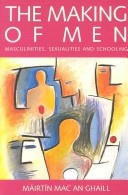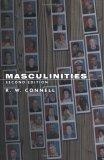98-1( 上學期)
Connell, R.W. (1999) The Big Picture: Masculinities in recent world history. In Jackson, S., Weeks, J. & Waites,.M. (Eds.) Sexualities and Society (pp. 46-56). Cambridge: Polity Press.
Holland, J., C. Ramazanoglu, S. Sharpe, & R. Thomson. (2004). Empowered men. In The Male in the Head: Young People, Heterosexuality and Power (pp. 135-155). London: Tufnell.
Holland, J., C. Ramazanoglu, S. Sharpe, & R. Thomson. (2004). Empowered women. In The Male in the Head: Young People, Heterosexuality and Power (pp. 117-134). London: Tufnell.
Holland, J., C. Ramazanoglu, S. Sharpe, & R. Thomson. (2004). Introduction: sex, gender and power. In The Male in the Head: Young People, Heterosexuality and Power (pp.1-12). London: Tufnell.
Holland, J., C. Ramazanoglu, S. Sharpe, & R. Thomson. (2004). Learning about sex: The gendering of sexual knowledge. In The Male in the Head: Young People, Heterosexuality and Power (pp. 51-75). London: Tufnell.
Holland, J., C. Ramazanoglu, S. Sharpe, & R. Thomson. (2004). Languages of love: Stories, lines and secrets. In The Male in the Head: Young People, Heterosexuality and Power (pp. 76-95). London: Tufnell.
Holland, J., C. Ramazanoglu, S. Sharpe, & R. Thomson. (2004). Positioning ourselves, representing others. In The Male in the Head: Young People, Heterosexuality and Power (pp. 13-27). London: Tufnell.
Holland, J., C. Ramazanoglu, S. Sharpe, & R. Thomson. (2004). The contradictions of condoms: Femininity, masculinity and sexual risk. In The Male in the Head: Young People, Heterosexuality and Power (pp. 28-50). London: Tufnell.
Holland, J., C. Ramazanoglu, S. Sharpe, & R. Thomson. (2004). The-male-in-the-head. In The Male in the Head: Young People, Heterosexuality and Power (pp. 156-174). London: Tufnell.
Holland, J., C. Ramazanoglu, S. Sharpe, & R. Thomson. (2004). When bodies come together: Power, control and desire. In The Male in the Head: Young People, Heterosexuality and Power (pp. 96-116). London: Tufnell.
Holland, J., C. Ramazanoglu, S. Sharpe, & R. Thomson. (2004). Unnatural heterosexuality: Resistance and change. In The Male in the Head: Young People, Heterosexuality and Power (pp.175-177). London: Tufnell.
Holland, J., Ramazanoglu, C., Thomson, R. (1996) In the same boat? The gendered (in)experience of first heterosex. In D. Richardson (Ed.), Theorising heterosexuality: Telling it straight (pp. 143-160). Buckingham: Open University Press.
Jackson, S. (1999) Heterosexuality, Heteronormativity and Gender Hierarchy: Some Reflections on Recent Debates. In Jackson, S., Weeks, J. & Waites,.M. (Eds.) Sexualities and Society (pp. 69-83). Cambridge: Polity Press.
Poummer, K. (1999) Intimate Citizenship and the Culture of Sexual Story Telling. In Jackson, S., Weeks, J. & Waites,.M. (Eds.) Sexualities and Society (pp. 33-41). Cambridge: Polity Press.
Weeks, J. (1999) Necessary Fictions: Sexual Identities and the Politics of Diversity. In Jackson, S., Weeks, J. & Waites,.M. (Eds.) Sexualities and Society (pp. 122-131).Cambridge: Polity Press.
98-2 (下學期)
Ashcraft, C. (2006). “Girl, You Better Go Get a Condom” Popular culture and teen sexuality as resource for critical multicultural curriculum. Teachers College Record, 108(10), 2145-2186.
Carpenter, L. (1998). From girls into women: Scripts for sexuality and romance in Seventeen Magazine, 1974-1994 , Journal of Sex Research, 35(2), pp.158-168.
Dentith, A. M. (2004). Female adolescent subjectivities in Las Vegas:Poststructural thoughts on the intersections of gender, sexuality, consumer logic and curriculum. Gender and Education, 6(4), 455-472.
Epstein, D., & Johnson, R. (1998). Learning sexualities. In Schooling sexualities (pp. xx-xx). Open University Press.
Epstein, D., O'Flynn S, & Telford, D. (2003). ‘Childern should be…’:Normalising heterosexuality in the primary school. In Silenced Sexualities in Schools and Universities, (pp. 15-32), VA:Trentham Books.
Epstein, D., O'Flynn S, & Telford, D. (2003). ‘I’ve no idea how to do it’: Sex education and teacher’s fears. In Silenced Sexualities in Schools and Universities. (pp. 33-50) VA:Trentham Books.
Fine,M., & Weis, L. (Eds.) (2003). Sexuality, Schooling, and Adolescent Females: The Missing Discourse of Desire. In Silenced Voices & Extraordinary Conversations. (pp. 38-67) NY: Teachers College Press.
Fine, M., & Weis, L. (Eds.) (2005). The Ideology of “Fag”:The School Experience of Gay Students. In Beyond Silenced Voices: Class, Race, and Gender in United States Schools (pp. 95-116). NY: State University of New York Press.
Jackson, S. (2005). ‘I’m 15 and desperate for sex’: ‘Doing’ and ‘undoing’ desire in letters to teenage magazine. Feminism and Psychology, 15(3), 295-313.
Kehily, M. (2002). Agony aunts and absences: an analysis of a sex education class. In Sexuality, gender and schooling: Shifting agendas in social learning (pp. 53-70). London: Routledge.
Kehily, M. (2002). More Sugar? Teenage magazines, gender displays and sexual learning. In Sexuality, gender, and schooling: Shifting agendas in social learning (pp. 71-91). London: Routledge.
Kehily, M. (2002). Producing heterosexualities: the school as a site of discursive practices. In Sexuality, gender and schooling: Shifting agendas in social learning (pp. 38-52). London: Routledge.
Kehily, M. (2002). Understanding masculinities:young men, heterosexuality and embodiment. In Sexuality, gender and schooling: Shifting agendas in social learning (pp. 92-116). London: Routledge.
Mac an Ghaill, M (1994). Schooling, sexuality and male power: Towards an emancipatory curriculum In The making of Men (pp. 153-169). PA: Open University Press.
Renold, E (2005). To be or not to be ‘girlie’:negotiating (hetero)sexualized femininities. In Girls, boys and Junior Sexualities (pp. 40-65). London: Routledge.
Tolman, L. (2009). Daring to Desire: Culture and the bodies of adolescent girls. In Weitz, R. (Ed.) The politics of women’s bodies: Sexuality, appearance, and behavior (pp. 100-121). NY: Oxford University Press.






